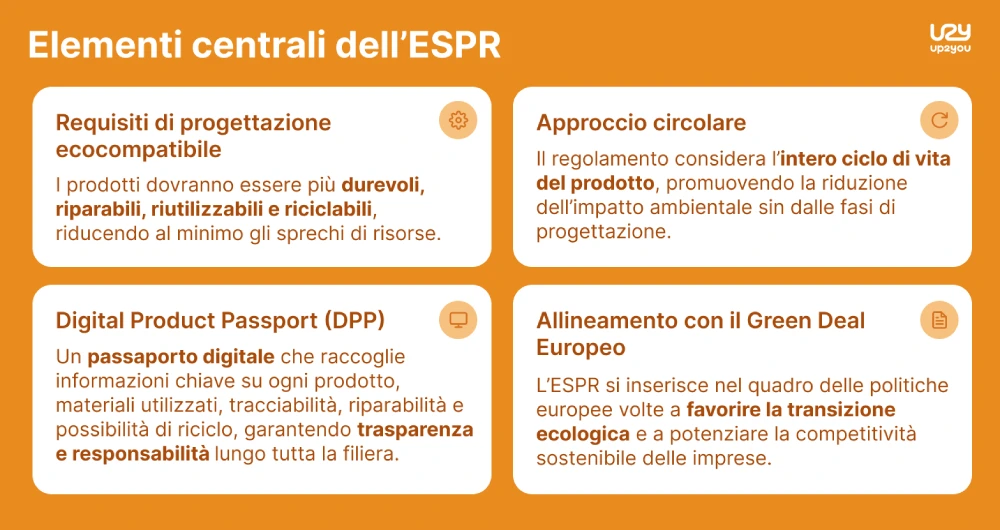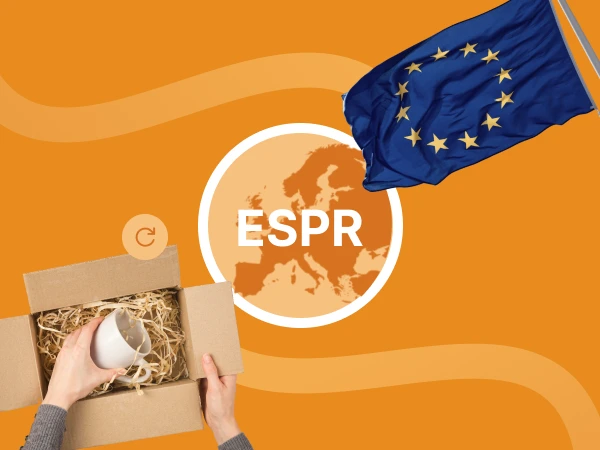{summary#bullet-1}
What is the ESPR regulation
The Regulation (EU) 2024/1781, known as Regulation on Ecodesign or EXPR (Ecodesign for Sustainable Products Regulation), marks a fundamental step by the European Union towards acircular economy and more sustainable.
Approved by the European Council in May 2024, it establishes the ecodesign criteria for products placed on the European market, with the objective of reduce environmental impact throughout the entire life cycle: from the extraction of raw materials to disposal.
The ESPR represents an evolution of Directive 2009/125/EC, which focused only on products related to energy consumption.
With the new regulation, the approach becomes much broader.
The ESPR ensures that the rules on ecodesign extend to almost all physical goods marketed in the EU, such as textiles, furniture, electronics and industrial equipment, making sustainability a mandatory and transversal principle.
In short, the ESPR regulation transforms sustainability from a voluntary choice to mandatory design criterion, paving the way for a market where products with the lowest environmental impact become even the most innovative, transparent and durable.
{summary#bullet-2}
What is the ESPR regulation for
The ESPR Regulation has a clear objective: make product design and production sustainable in Europe, promoting a truly circular and competitive economy.
Through the introduction of harmonized requirements at European level, the ESPR aims to ensure that all products placed on the market comply common standards of efficiency, durability and environmental sustainability.
In particular, the regulation serves to:
- promote the dissemination of sustainable products, encouraging the creation of repairable, recyclable, durable and energy efficient goods and reducing the amount of waste generated;
- create a stronger and more coherent single market, avoiding fragmentation between member countries and preventing trade barriers linked to different national regulations;
- strengthening the competitiveness of European companies, simplifying administrative burdens and rewarding companies that invest in innovation and sustainability;
- facilitate consumer choices, thanks to clear and comparable information on the environmental impact of products. In this sense, the ESPR works in synergy with the Framework Regulation on Energy Labeling (ELFR), which helps citizens to identify the most efficient and environmentally friendly products.
We therefore understand how the ESPR is not only a technical regulation: it is a strategic tool for European ecological transition, which aims to make sustainability a competitive advantage for businesses and a natural choice for consumers.

{summary#bullet-3}
The 7 objectives of the ESPR regulation
The ESPR Regulation is not only a technical measure, but a long-term European strategy to change the way products are designed, made and consumed.
His objectives touch every phase of the value chain industrial, from production to distribution, to consumption and the end of life of the product, with the intention of making sustainability a structural characteristic of the market unique European.
Let's see what the main objectives of the regulation are
1. Promoting the circular economy
The ESPR aims to make products more durable, repairable and recyclable, extending their life cycle and reducing waste. Priority products are selected based on their potential contribution to circularity, pushing industrial sectors towards regenerative production models.
2. Improving energy and resource efficiency
The regulation introduces minimum environmental and energy performance requirements, encouraging the more efficient use of natural resources and reducing the consumption of energy and materials.
3. Provide clear and transparent information to consumers
Through tools such as energy labeling and the future Digital Product Passport (DPP), citizens will be able to access verifiable data on the environmental impact of the goods purchased. This information will be integrated into the European Register of Energy Labeling Products (EPREL).
4. Reduce theecological footprint and climate of the products
One of the most innovative elements introduced by ESPR is the Digital Product Passport (DPP), a real digital document that accompanies each product throughout its life cycle. The DPP will contain complete and verifiable information on the composition, origin of materials, durability, repairability, recyclability and proper disposal, making every phase of the value chain transparent. Thanks to a QR code or a digital link, consumers, companies and authorities will be able to easily access this data, encouraging more informed purchasing choices and a more responsible management of resources.
5. Strengthening the European Single Market
By harmonizing requirements across all member states, the regulation avoids trade barriers and guarantees fair competition conditions for all businesses.
6. Increase the competitiveness of European companies
Companies that innovate in a sustainable way benefit from a competitive advantage, positioning themselves as leaders in the production of “circular ready” products, increasingly in demand by the global market.
7. Contributing to the European Union's climate objectives
The ESPR is fully aligned with European Green Deal and contributes to achieving climate neutrality by 2050, reducing energy consumption and CO₂ emissions at a systemic level.
{summary#bullet-4}
Which companies are the ESPR regulations aimed at
The ESPR Regulation applies to all companies that place products on European Union market, regardless of their country of origin or the size of the company.
In other words, any manufacturer, importer or distributor operating in the single European market must guarantee that their products comply with the new ecodesign requirements provided for by the regulation.
THEESPR significantly expands the field of application compared to the previous Ecodesign Directive, which focused exclusively on products related to energy consumption. The The new regulation, on the other hand, includes almost all physical goods, involving a wide range of industrial and manufacturing sectors.
Let's see which sectors are most involved.
Household appliances and consumer electronics
Refrigerators, washing machines, dishwashers, televisions, monitors, bulbs and lighting devices must meet requirements for durability, repairability and reduced energy consumption.
ICT (Information and Communication Technologies) Industry
Servers, network systems and data centers will be called upon to improve energy efficiency and reduce environmental impact, in line with the increasing digitalization of infrastructures.
Manufacturing and industrial machinery
Electric motors, fans and air conditioning systems must be designed to ensure greater efficiency, recyclability and lower emissions.
Automotive and transport
Even if vehicles are not directly within the scope of application, components such as tires, batteries and electronic parts will be subject to recyclability and durability requirements.
Packaging and packaging
The packaging sector will need to adopt more sustainable materials, reduce the use of harmful substances and improve the recyclability of plastic, paper and composite materials.
Textile and footwear sector
The ESPR introduces a ban on the destruction of unsold products (with a temporary exemption for SMEs) and imposes criteria for durability, repairability and the use of recycled materials, encouraging circular models even in fashion.
Furniture and decor
The furniture industry must move towards modular and circular design, the use of recycled or recyclable materials and the reduction of chemicals that hinder recycling.
Chemicals and construction materials
Insulating materials, paints, cements and steels must comply with sustainability requirements, improving the energy efficiency of buildings and limiting the use of non-recyclable materials.
Products sold online
Even goods marketed through e-commerce will be subject to the new ecodesign requirements. The Digital Product Passport (DPP) will guarantee transparency and traceability even for digital sales.
{summary#bullet-5}
What are the social and business advantages of complying with the ESPR regulation
The adoption of the ESPR Regulation is not only a regulatory obligation, but a great one opportunities for growth and innovation for businesses, consumers and for the environment.
Applying the principles of ecodesign means creating value along the entire production chain, promoting a more efficient, transparent and sustainable economy, also promoting a competitive advantage for the companies that apply them.
Let's see what the advantages are for consumers
More durable and repairable products
Assets designed according to ESPR criteria will be longer lasting, easier to repair, and upgradable, ensuring greater convenience and reducing the need for frequent replacements.
Access to transparent information
Thanks to the Digital Product Passport, consumers will be able to clearly know the composition, durability, repairability, how to recycle and dispose of products, often through a simple QR code.
Long-term economic savings
More efficient and durable products translate into lower energy and maintenance costs, generating a concrete economic advantage over time.
Instead, let's see what are the advantages for companies
Competitive and reputational advantage
Companies that invest in ecodesign can differentiate themselves on the market, responding to the growing demand for sustainable products and strengthening their corporate image.
Reduction of operating costs
More efficient production processes mean less waste, lower disposal costs and reduced resource consumption, improving business profitability.
Drive for innovation
The regulation represents an engine for the research and development of ecological solutions, stimulating the birth of new business models and low-impact products.
Compliance and access to the European market
Respecting the ESPR means avoiding trade barriers and ensuring compliance with the environmental requirements of the European Union, facilitating the participation of companies in the single market.





























